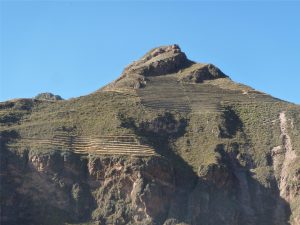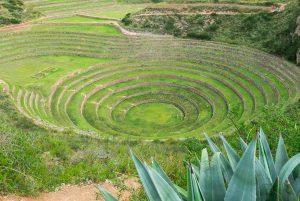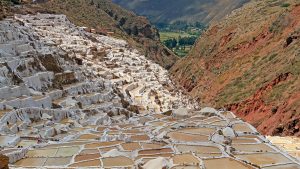Maras: In the middle of the imposing Andean landscapes of the Sacred Valley of Cusco, the small town of Maras keeps a unique richness that mixes history, tradition and an impressive geography. About 40 kilometres from the city of Cusco, this district has become an obligatory stop for those who wish to go beyond the conventional tourist destinations.

🧂 The salt mines of Maras: a living legacy
The most famous attraction of Maras is, without a doubt, its salt mines. There are more than 3,000 staggered pools where salt has been produced by hand since pre-Inca times. The salt water emanating from a natural spring is directed by channels to each pool, and the Andean sun does the rest: evaporation leaves white, pink and even reddish salt crystals, which are now sold in Peru and abroad.
The most amazing thing is that this system is still managed by local families, in an admirable display of ancestral technology that has survived centuries without the need for modernisation.

🛠️ Communal wisdom: a lasting legacy
Each salt pan has an owner, but the rules for its use are based on ancestral principles of cooperation, family inheritance, and reciprocity, very similar to the Inca system of organization. Local families are responsible for the maintenance, harvesting, and distribution of the salt, just as their ancestors did.
During the dry season (May to September), community members harvest the salt by hand, using a traditional process that has remained unchanged for centuries. Three types of salt are obtained: fine white salt, pink Andean salt, and coarse salt.

🌍 A sacred… and sustainable resource
For the ancient Andean peoples, salt was not just a condiment: it was medicine, currency, and a symbol of purity. Today, the Maras Salt Mines continue to be an example of how it is possible to live in balance with nature. Despite the arrival of tourism, the community maintains firm control over the site, ensuring that its exploitation remains sustainable and community-based.
📸 Maras today: between history and tourism
Visiting the Maras Salt Mines is like looking through a window into the past. The contrast of colors, the silence of the valley, and the quiet work of the community members offer a unique experience. Although today they are a popular tourist attraction, the salt mines have not lost their essence: they remain a sacred, useful, and deeply human space.
🧂 Types of salt and properties
The Maras Salt Mines produce different types of salt:
-White salt: the most common, used in everyday cooking.
-Pink salt from Maras: highly valued internationally for its texture and minerals, it contains iron, magnesium, calcium, and zinc.
-Fleur de sel: the thinnest and purest layer that forms on the surface, with a delicate flavor, ideal for gourmet dishes.
This salt is not only delicious, but also 100% natural, without additives, and free of chemical processes.

✨ A tip for travelers
If you visit Cusco and the Sacred Valley, be sure to visit Maras. Walk slowly, observe the details, and respect the legacy of these pools that have been filled, emptied, and cared for by hundreds of generations.
🌿 Responsible tourism and a sustainable future
Today, the salt flats are an important tourist destination. Tens of thousands of people visit them every year to admire their beauty, buy artisanal salt, and learn about traditions that have survived for centuries.
However, the local community has implemented measures to protect this heritage from mass tourism. Since 2020, direct access to the pools has been prohibited to prevent contamination, but visitors can observe them from safe viewpoints and walk along marked trails.
By purchasing local products—such as salt, artisanal chocolates, balms, or soaps made with pink salt—you directly support the families who preserve this ancestral legacy.









Leave A Reply